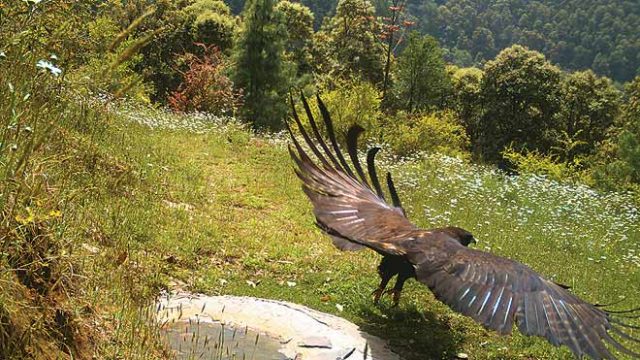Not everyone is fortunate enough to have a wildlife sanctuary in his or her backyard, but for me, it’s one of the advantages of living in Mussoorie. For more than 50 years, I have been visiting Flag Hill, a forested ridge to the east of Landour, which gets its name from the Tibetan prayer flags tied on the summit. This 100 acres of unspoiled jungle is barely a 15-minute walk from my home. Six months ago, Flag Hill became part of the Jabarkhet Nature Reserve (jabarkhetnature.com), which is the first privately owned and operated wildlife sanctuary in Uttarakhand.
At an elevation of approximately 2,000 metres above sea level, JNR is ideally situated across several different altitudinal zones, with a wide variety of plants, fungi, ferns, trees, insects, reptiles, birds and mammals. Atop the first range of the Himalaya, it lies along the migratory flyways for many avian species from rose finches to bar-headed geese (though these high fliers never touch down and can only be heard honking overhead). As a boy, I learned many lessons in natural history on Flag Hill: how to tell the difference between a poisonous pit viper and a non-poisonous garter snake; how to imitate the call of a mountain scops owl or an Indian cuckoo; and how to diagnose whether a leopard has eaten a langur monkey or a goral for dinner, from the undigested hairs in its scat.

Jabarkhet Nature Reserve has been set up as a partnership between the owner of the property, Vipul Jain, and Sejal Worah, a lifelong conservationist who is director of the reserve. Vipul’s father, J.P. Jain, was a lover of nature who took care of his property with a purposeful eye to utilising its natural resources without depleting the forest. JNR is dedicated to his memory and his vision. Working tirelessly over the past two years to establish the reserve, even as she carries on with a full-time job at WWF, Worah has dedicated herself to protecting the rich biodiversity of Flag Hill and sharing it with others. As a model for conservation on private land, JNR is unique. Through individual and institutional membership, one-time entry fees, as well as school field trips and research activities, JNR aims to pay for itself, rather than being an NGO that solicits donations. The guards and naturalists who look after JNR are hired from villages and settlements close to the reserve and this helps create community investment in the project. They are paid out of the money received from visitors, which also helps cover the cost of maintaining nature trails and water holes. This innovative form of entrepreneurial conservation has been tried and tested in many countries abroad but this is the first venture of its kind in India.

For me, there are purely selfish reasons to see this wonderful initiative succeed. At least once a week, and often more frequently, I get up at first light and look out my window to see the lower Himalayan ranges silhouetted to the east. Stuffing binoculars and camera into my pack, I set off for Flag Hill, just as I did when I was a young boy, hoping to discover something I’ve never seen before. Leaving the last houses behind and approaching the familiar contours of the ridge, which is still in shadow, I can hear the calls of common hill partridges and green pigeons, as well as the sharp alarm cry of a barking deer. Darkness lifts and nocturnal creatures begin to retreat for the day. Himalayan black bears, who feast on acorns and dogwood fruit, have already disappeared and wild pigs and porcupines are heading into the valleys after rooting up trails during the night. Five months ago, I was lucky enough to see a leopard at daybreak, sunning himself on a grassy slope, before he slinked away to his lair.

Mornings are the finest time to be in a forest, for you have a chance to encounter both the night shift of animals on their way home and the daily commute of others clocking-in with the dawn. One of the exciting new aspects of the Jabarkhet Nature Reserve has been the creation of several small waterholes and the installation of camera traps. Animals that we seldom see can take their own photographs and mark themselves present, even when no humans are around. The educational potential of these camera traps is enormous. Visiting students can observe and monitor different species without causing much disturbance. JNR has also developed a range of interpretive materials and a map to help visitors identify the different species they encounter.
As we look for new ways to celebrate the outdoors and protect our planet, independent initiatives like the Jabarkhet Nature Reserve offer as yet unmapped trails for conservation. It’s also an opportunity to educate and inspire future generations of nature lovers. In this way, we can explore, appreciate and protect small areas of undeveloped private land by understanding their value and investing in something that enriches our lives without leaving indelible footprints behind.




